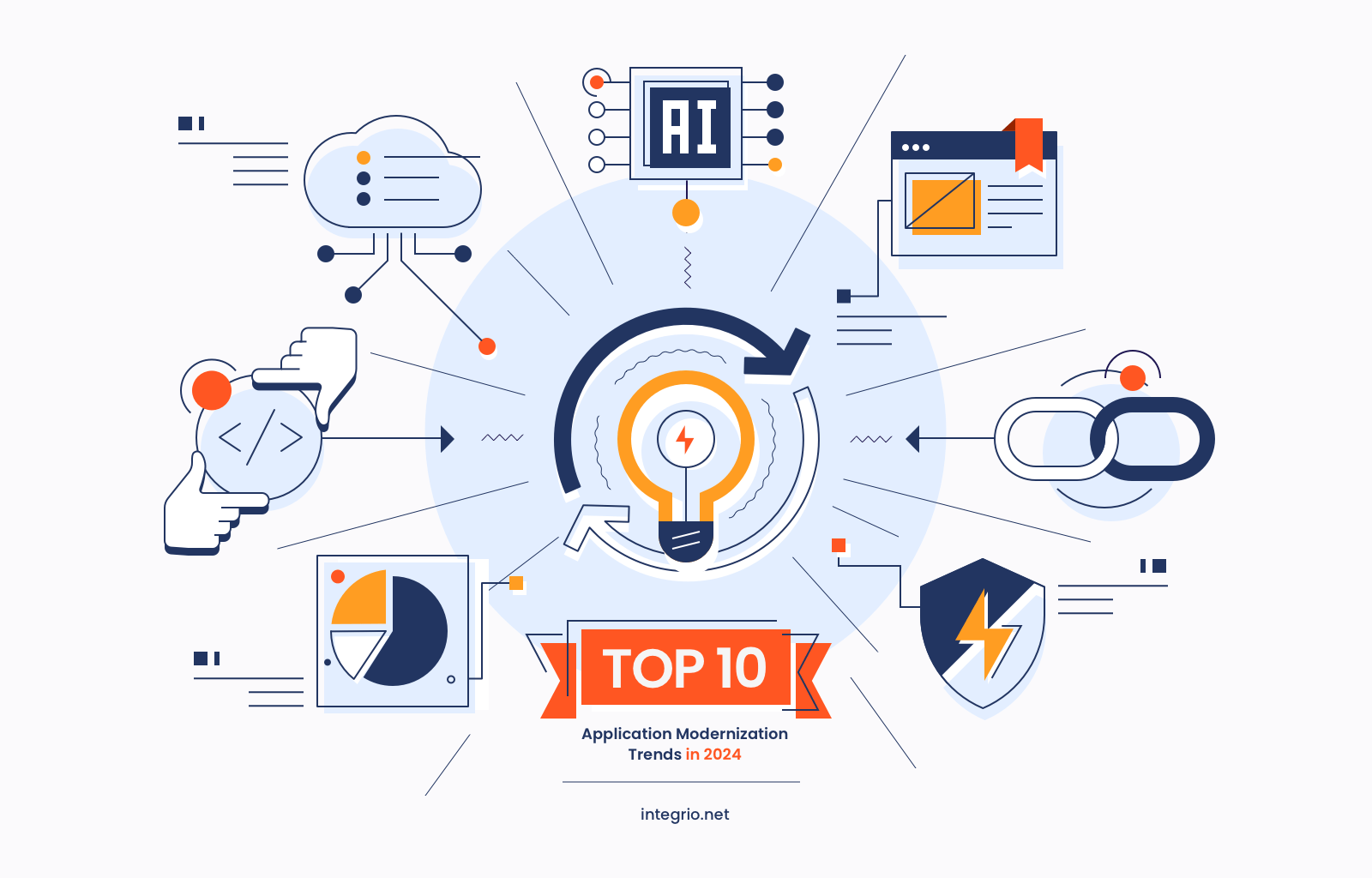Top 10 application modernization trends in 2024

Today, the industry of legacy software upgrading is prospering. The Application Modernization Services market, valued at $19.7 billion in 2022, is projected to reach $66.4 billion by 2030, with a CAGR of 16.4%.
Companies modernize their apps to stay competitive, adapt to evolving technology, and meet changing business needs. Employing new technologies and approaches, they enhance efficiency, user experience, and security while ensuring compatibility with industry standards.
Do you want to upgrade your system? Then, it's time to take a closer look at the trends in application modernization in 2024. As a trusted developer with 23+ years of experience, Integrio will discuss the importance of legacy system improvements and consider the main strategies to boost your business processes. This article will discuss artificial intelligence and machine learning, DevOps practice, low-code development, blockchain, and other technologies.
What Is Application Modernization, and Why Is It So Important?
Application modernization is updating existing software applications to address challenges posed by legacy systems. Even if you are not a young progressive startup, you should incorporate the latest technologies in the current platform to get:
quick response to evolving business requirements, market situation, and industry trends
increased operational efficiency and optimized workflows
better user satisfaction and loyalty to your company
significant cost savings over time
integration of new and emerging technologies
consistent performance even with growing user demands and increased workloads
data protection and compliance with current regulations
And this is modernization ways you should consider:
Upgrade user experience with updated designs, intuitive navigation, and responsiveness. This way, you shouldn't replace the entire legacy system.
Develop robust, scalable software with a future-proof infrastructure, emphasizing performance and portability.
Streamline operations with automated process modernization to reduce complexity for efficient, error-free workflows and enhance productivity.
Support ongoing updates to ensure systems stay current with technology trends. This allows a step-by-step approach rather than overwhelming leaps.
10 Best Application Modernization Trends in 2024
Let's delve into the trends in application modernization that will redefine how businesses optimize, secure, and innovate their systems.
1. Low-Code & No-Code Development
Low-code and no-code development makes it easier for people to create applications by providing visual interfaces and drag-and-drop tools. With pre-built components, you don't need to be a coding expert and can update your apps quickly with less coding effort.
Citizen developers without traditional coding skills now actively participate in app building and designing user interfaces and workflows. This way, you address the challenge of experts shortage, accelerate innovations, and automate business processes.
Today, companies leverage low- and no-code web development with solutions like Salesforce and Microsoft Power Apps to create powerful applications without extensive coding. This makes platform creation more accessible, efficient, and inclusive.
2. Cloud-Native and Hybrid Solutions
The cloud has transformed digital experiences, introducing innovations like mobile payments. For many legacy applications, such modernization becomes essential. Cloud-native platforms empower dedicated developers to apply related principles and tools, facilitating the deployment of new digital workloads with greater flexibility.
Its key principles include microservices architecture, containerization, orchestration, and DevOps practices. We will consider some of them in more detail in the following sections.
In some scenarios, full cloud modernization may not be necessary, leading to the prominence of hybrid technology. Based on their business goals and budgets, organizations can integrate public, private, and hybrid clouds. Public clouds offer scalability to manage usage spikes at lower costs, and hybrid ones provide an alternative when complete migration offers little or no financial gain.
3. Microservices Architecture
Microservices change the way we build applications. Instead of having one giant piece of code, break it into smaller parts that can be updated independently. In traditional monolithic applications, a single large codebase handles all functionalities. On the other hand, microservices operate independently, with each feature or application managing a specific service.
This shift to microservices greatly improves the development and deployment of updates and new features. The technology stacks become more adaptable, and the risk of downstream effects associated with changes in the underlying code is minimized. This allows for a more dynamic and responsive approach to evolving business needs.
4. Containerization
Containerization is important as we often use different technology stacks with specific needs. Building an app on one system and then moving it to another for deployment can lead to unexpected errors and bugs.
The main idea behind containerization is to ensure your app runs consistently, no matter where it ends up. It achieves this by packaging all the essential parts of your solution – like files and code – into one portable unit known as a container. Today, Docker and Kubernetes are professionals' go-to solutions for smooth operations.
5. Artificial Intelligence (AI) and Machine Learning (ML)
Artificial Intelligence (AI) and Machine Learning (ML) are changing how we update apps, making the process faster and smarter. These technologies enhance the efficiency of modernization by automating code analysis, testing, and performance optimization.
In sectors like banking and eCommerce, AI and ML empower applications to gain valuable insights into customer behavior. It enables the development of personalized features like AI-driven chatbots, recommendation engines, and predictive analytics. This not only elevates user experiences but also automates decision-making processes.
6. Infrastructure Replatforming, Refactoring, and Repurchasing
Companies strategically employ various cloud migration techniques, like replatforming, refactoring, and repurchasing.
Replatforming involves upgrading essential components like databases and operating systems while preserving the core code and application structure. This approach allows companies to enjoy the advantages of newer technologies without requiring extensive code modifications.
In contrast, refactoring entails a deeper transformation involving re-architecting existing applications with technologies like containerization with Kubernetes and serverless architecture.
Another option is repurchasing, where companies transit from traditional one-time purchases to software-as-a-service (SaaS) models. It enhances accessibility and scalability and reduces maintenance overhead.
The main goal of these strategies is to lower your investment in traditional data centers by taking advantage of cloud infrastructure. It also simplifies operations by optimizing the application environment so you can control and maintain your platform easily. Finally, companies are able to meet ever-changing needs and optimize their resources with modern technologies.
7. DevOps Approach
DevOps is a key player in updating apps. It focuses on teamwork, reducing risks, and improving software quality. By using automation, it cuts down on mistakes and boosts efficiency, saving costs in the process. DevOps experts and tools enable businesses to modernize legacy code according to their unique needs and requirements.
Integrating new tech like cloud services, Infrastructure as Code (IaC), containers, GitOps, and observability in DevOps makes the modernization process more effective.
The DevOps approach is gaining even more popularity for escalating cybersecurity concerns. For example, it helps businesses integrate security practices throughout the entire product life cycle. Consider DevSecOps to protect your application from potential vulnerabilities that could compromise application integrity.
8. Robotic Process Automation (RPA)
Employing Robotic Process Automation (RPA) is a standout technology for organizations seeking efficient and cost-effective automation solutions. It offers a unique advantage by enabling the automation of repetitive tasks without requiring substantial initial investments or advanced technical expertise.
This automation not only mitigates the risk of human error but also significantly reduces the time needed to complete tasks. It also liberates employees from mundane, repetitive work so they can focus on more meaningful and intellectually demanding tasks that require abstract thinking.
9. Blockchain Integration
Blockchain integration is a key trend in 2024 for secure and transparent data management. It provides real-time access to trustworthy information. This decentralized approach reduces delays, errors, and fraud, enhancing accountability and transparency. At the same time, all data is recorded and cannot be changed without the consent of all participants.
Here, cryptography is used to secure transactions and control access to the blockchain. Public and private keys are employed to authenticate participants, ensuring data integrity and privacy.
In supply chain management, blockchain ensures product authenticity, reducing the risk of counterfeit goods. In finance, it facilitates secure and transparent transactions, cutting the need for intermediaries. Healthcare benefits from secure and interoperable health records. Blockchain's application in smart contracts automates business processes with predefined rules.
10. RegTech and Enhanced Security Measures
RegTech utilizes innovative technologies to streamline and automate compliance processes, ensuring organizations can adhere to complex regulatory frameworks efficiently. Moreover, such solutions often incorporate advanced analytics and reporting capabilities, improving informed decision-making and risk management.
This trend is increasingly vital as regulatory landscapes become more intricate, requiring a sophisticated approach to compliance.
By adopting robust security protocols, organizations safeguard their applications against unauthorized access, data breaches, and other cyber risks. Multi-factor authentication, encryption, continuous monitoring, and other security measures bolster the resilience of modernized applications. These measures not only protect sensitive data but also instill confidence among users and stakeholders.
How Integrio Can Assist You in Implementing Cutting-Edge Modernization Trends
Addressing application modernization trends, from cloud-based development to integrating artificial intelligence and improving security, is the way to unlock flexibility, innovation, and sustainable relevance. This way, you can improve user experience, reduce costs, and optimize internal processes.
Do you want to know more about trends relevant to your business? At Integrio, we are ready to provide professional technical support and consultancy covering the application modernization roadmap. As developers, we modernize legacy systems for aviation, manufacturing, real estate, telecommunications, transportation, digital marketing, health, and fitness.
Our company uses modern strategies in IT infrastructure, modern web app architecture, software, and systems migration methods. Contact us to discuss project details.
Contact us

